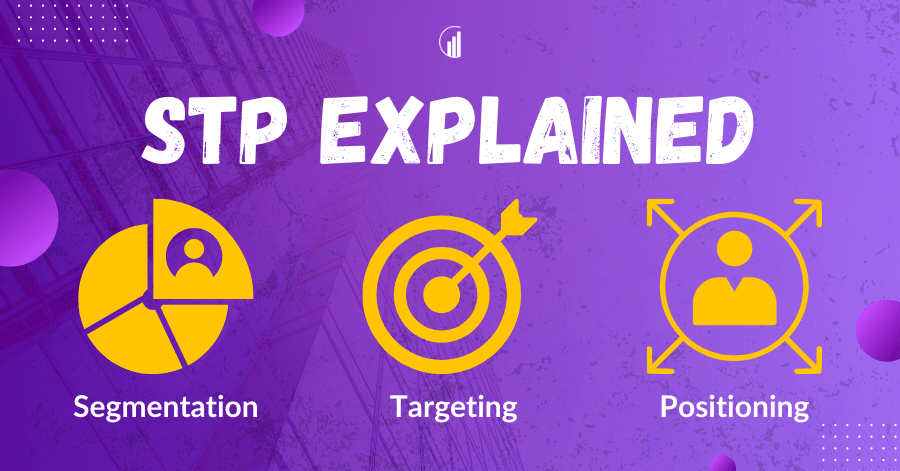Have you ever wondered how some businesses easily dominate their markets while others struggle to make an impact? It’s all about strategy. Today, we’re diving into the powerful world of Segmentation, Targeting, and Positioning (STP) – a game-changer for market dominance. let’s Start our journey!
Table of Contents
What Is STP?
STP, which stands for Segmentation, Targeting, and Positioning, is a smart strategy that businesses use to win customers. First, they segment or divide the market into groups based on things like age, interests, or location.
Then, they target specific groups with products or messages that best fit their needs. Ultimately, they make their brand stand out from competitors in the minds of customers.
It’s all about finding the right people, offering them the right things, and making sure they remember you for all the right reasons!
What is Segmentation?

Segmentation in marketing is first word ‘S’ of “STP”. It is like using a magnifying glass to understand customers better. Imagine you have a big group of friends, but each one is unique, right? Similarly, in marketing too, not all customers are the same.
Segmentation helps businesses divide this large group into smaller, more manageable groups based on similarities such as age, interests, or location. This makes it easier to target specific groups with products or messages that really resonate with them.
For example, a sports brand may target younger athletes differently than older fitness enthusiasts. By segmenting, businesses can optimize their approach and engage with their audience more effectively, ultimately boosting sales and customer satisfaction.
Therefore, segmentation is not just about segmentation – it is about conquering the market by understanding and serving different customer needs.
What Is Targeting?

Targeting in marketing, especially as part of an STP (Segmentation, Targeting, Positioning) strategy, is like hitting the bullseye with a dart. Once a business has divided its market into smaller groups (that’s segmentation), targeting comes next.
This means choosing the right group to focus on – like teens who love gaming or busy moms who want a quick meal solution. By targeting specific groups, businesses can match their products, promotions, and messages to what these customers really want and need.
It’s all about targeting your efforts where they will have the greatest impact. When businesses set their goals, they are more likely to connect with customers in a meaningful way, build loyalty, and increase sales. Therefore, targeting does not mean reaching everyone; It’s about reaching the right people.
What Is Positioning?

Positioning in last word ‘P’ of “STP”. It in marketing depends on how a company wants its products or services to be viewed by customers in comparison to competitors.
Imagine that you are in a crowded room with many people. Every person wants to stand out and be remembered for something special. Similarly, in marketing, businesses aim to position themselves uniquely in the minds of customers. This could be by highlighting quality, affordability or innovation.
For example, a luxury car brand positions itself as high-end and prestigious, while a budget-friendly brand focuses on affordability and practicality.
Effective positioning helps businesses create a clear and compelling identity, making it easier for customers to choose their brand over others. It’s like defining your own spotlight in a crowded marketplace, ensuring customers see you exactly how you want to be seen.
Difference between Segmentation, Targeting and Positioning in STP.
A detailed comparison table explaining the difference between segmentation, targeting and positioning in simple words for easy understanding is given below:

| Aspect | Segmentation | Targeting | Positioning |
|---|---|---|---|
| Definition | Dividing the market into distinct groups | Selecting the specific group to focus on | Establishing a unique image for the brand |
| Purpose | Identifying different customer segments | Choosing the ideal target audience | Differentiating the brand from competitors |
| Process | Grouping customers based on similarities | Selecting the most profitable segments | Communicating unique benefits to customers |
| Focus | Market segmentation | Target market | Brand positioning |
| Outcome | Smaller, manageable customer groups | Precise targeting for marketing efforts | Distinct brand identity in the market |
| Example | Classifying by age, interests, location | Targeting young adults for a new gadget | Positioning a luxury car as prestigious |
| Importance | Helps tailor marketing strategies | Maximizes efficiency in marketing | Builds brand reputation and recognition |
What are the STP Process?
Let’s break down the STP (Segmentation, Targeting, Positioning) process in a conversational and easy-to-understand way:
Imagine you’re planning a big party. First, you’ll want to figure out who your guests are—it’s like segmentation in marketing. You divide your guest list into groups based on their interests, such as friends who love music or family members who enjoy outdoor activities.
Next comes targeting, where you decide which group to focus on. Just like choosing which friends to invite to the dance-off!
Finally, there’s positioning, which is all about how you want your party to be remembered. Do you want it to be the coolest dance party in town or a place to chill out with great food?
In marketing, this means creating a unique image for your brand that stands out from the competition. By following these steps – segmentation, targeting, and positioning – you can throw a memorable party (or market your product) that everyone will love!
STP examples of a company which is used this strategy.
Let’s look at an example of a big brand using the STP strategy :
Have you ever heard of Nike? They are a perfect example of a big brand that uses STP to connect with their customers. First, let’s talk about segmentation. Nike divides its market into different groups based on factors such as age, lifestyle and interests. For example, they have products specifically for athletes, casual wearers, and even fashion enthusiasts.
Next comes targeting. Nike chooses to focus on athletes and sports fans who value performance and style. They create shoes, apparel, and accessories to meet the needs and desires of these customers.
Ultimately, positioning is where Nike really shines. They have established themselves as a premium brand known for innovation, quality and empowerment through sports. Their slogan “Just Do It” embodies this position, inspiring people to push themselves beyond their limits.
By using STP effectively, Nike has become a household name around the world, connecting with diverse customer segments while maintaining a strong brand identity.
Market Segmentation, Targeting and positioning Pdf.
If you have come this far, it means that you are very interested in getting information related to marketing. So let me suggest you some more blogs which are related to marketing. So please read these blogs also “Will AI Replace Digital Marketing” , “Best Digital Marketing Agency In Bihar”.
FAQ Section
Why STP is important In Marketing?
STP (Segmentation, Targeting, Positioning) is important in marketing because it helps businesses identify specific customer groups, tailor offerings to effectively meet their needs, and establish a unique brand positioning, thereby attracting customers. satisfaction and competitive advantage increases.
What are STP in Marketing?
STP in marketing means Segmentation, Targeting and Positioning. It is a strategic approach where businesses segment the market, select specific customer groups, and tailor their offerings to effectively meet the needs of those groups.
How to do STP in Marketing?
To do STP (Segmentation, Targeting, Positioning) in marketing, first segment the market on the basis of characteristics. Next, select target segments to focus on. Finally, position your brand uniquely in the minds of your chosen audience.
What is STP in Marketing definition?
STP in marketing means Segmentation, Targeting and Positioning. It is a strategic approach where businesses segment the market, select specific segments to target, and uniquely position their products or brands to appeal to those segments.
What are the 4 types of target market segmentation?
The four types of target market segmentation are demographic, geographic, psychographic, and behavioral segmentation.
What are the 4 target marketing processes?
The four target marketing processes are market segmentation, target market selection, positioning and differentiation.

